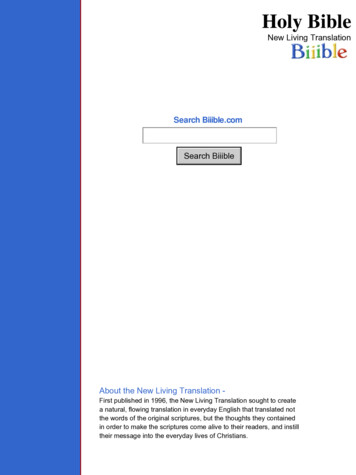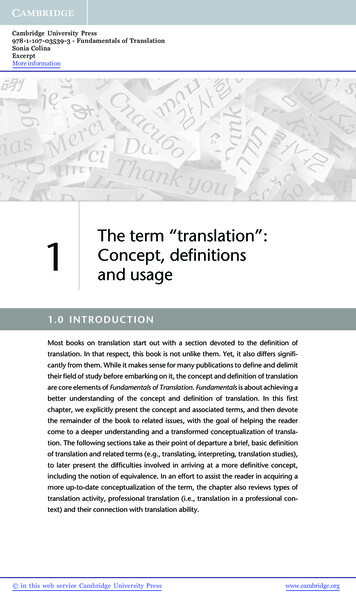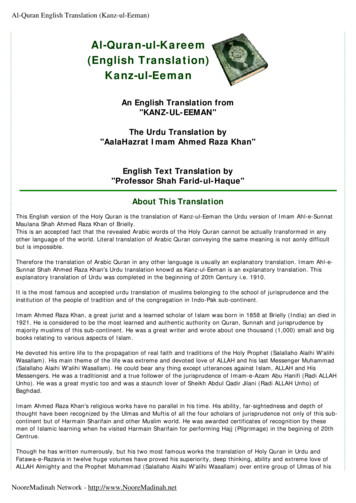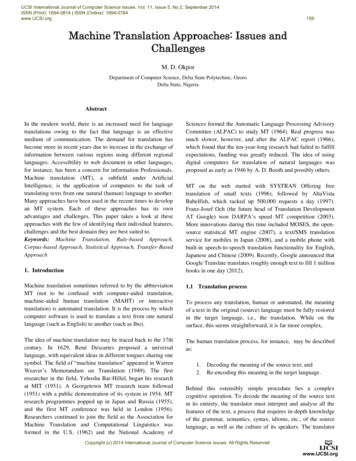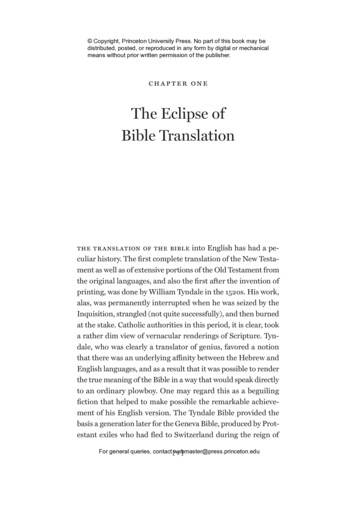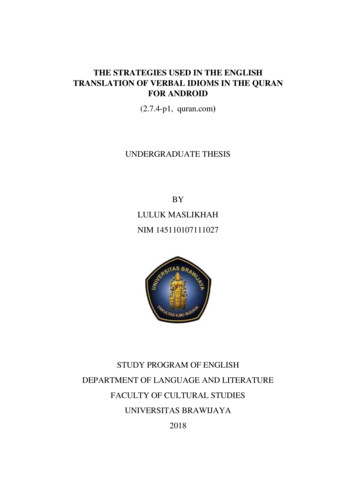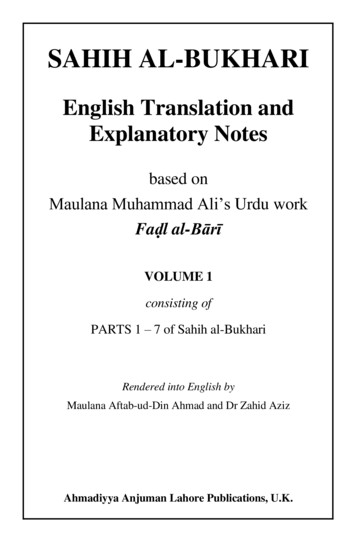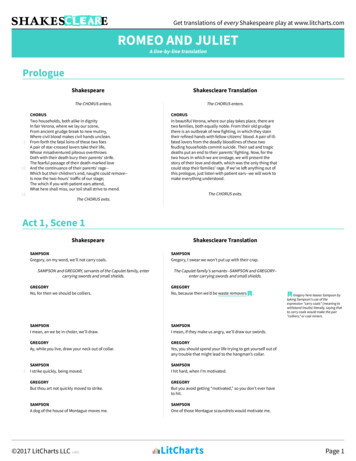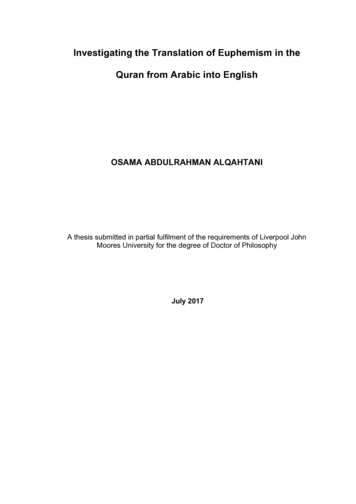
Transcription
Investigating the Translation of Euphemism in theQuran from Arabic into EnglishOSAMA ABDULRAHMAN ALQAHTANIA thesis submitted in partial fulfilment of the requirements of Liverpool JohnMoores University for the degree of Doctor of PhilosophyJuly 2017
AbstractThis study investigated the accuracy and quality across five different translations of theQuran from Arabic into English, focusing on euphemism. It evaluated the degree offaithfulness or deviation in meaning from the original and corroborated whether this isdue to the translating approach or inadequate understanding of the meaning of Quranictext. It assessed the main features of euphemistic expressions in the Quran, howeuphemistic expressions have been translated, and provided recommendations onhow to improve the translation of euphemistic expressions in the Quran.Throughout its long history, translation and translation studies have never been freefrom conflicting views. Translation is one of the most researched topics and no otherissue has preoccupied theorists and practitioners as much as the translation debatewhich has brought about a split of views, specifically into those who claim thattranslation is an art and those who believe that translation is a science. Each campputs forward unrealistic expectations of what translation is and what it can achieve.Despite the boom in translation studies over the last decades which has providedinteresting and fresh insights, it remains an area which has little theoretical base andvery few research landmarks. Translation has rarely managed to rise above merecomparative analysis of language pairs, examining their cross linguistic and culturaldifferences. Translation approaches, procedures and techniques are not one size fitsall. They may work well for Indo-European languages but may not for Semiticlanguages, for instance. They are often prescriptive, abstract and lack practicalimplications.Highly expressive and colourful components of any language are often deliberatelysubstituted by euphemistic expressions. Euphemism is thus a purposeful act ofsoftening existing terms or expressions with neutral, courteous and ‘clean’ words.Euphemism is said to be a form of deception. This study examined the translation ofeuphemism in the Quran focusing on the English versions of the Quran by AbdelHaleem, Khan and Al-Hilali, Yusuf Ali, Arberry, and Pickthall. It was found thattranslators often underestimate the complexity of translation, particularly the translationof euphemism in the QuranBased on the nature of the problem and the research questions, the method adopted inthis study used a qualitative approach starting with text based analysis of a broadsample of euphemistic expressions from the five selected versions of translations ofthe Quran. This was supported by semi-structured interviews with professionaltranslators to gauge their views and perceptions regarding the meanings of euphemismin the Quran.The key findings suggest that there is no single method which will address all of thechallenges faced by the translators of euphemisms of the Quran. Moreover, manyIslamic concepts and cultural bound items are untranslatable, thus loss of somemeaning is inevitable. Findings revealed that straightforward and mechanical transferof euphemisms from the Quran produces meaningless or clumsy utterances becausethere is no direct correspondence between Arabic and English euphemisticexpressions. Therefore, translating euphemism in the Quran goes beyond merelinguistic transfer.This study has several practical implications. Firstly, it will benefit translators of theQuran by providing fresh insights into dealing with some of the challenges oftranslating euphemism from the Quran. Secondly, it will provide a platform for furtherresearch on translating euphemism as it has expanded the existing literature ontranslating euphemistic expressions from the Quran to benefit future researchers.ii
AcknowledgmentsFirst and foremost, I thank Allah Almighty for giving me the ability to completethis study.I am extremely grateful to my former supervisor Dr. Karim Menacere for hissupport, valuable advice, and constructive suggestions which helped me andguided me throughout the journey of this research. My thanks are alsoextended to my current Director of Studies, Dr. Elena Teso, who continued thejourney with me and gave me useful advice and guidance. My thanks are alsodue to Dr. Scott Foster for his continued support and encouragement.I would like to express special thanks to my father Dr. Abdulrahman Alqahtani.He has been a role model, a mentor, and an inspiration to me throughout mylife and without him I would not have been able to accomplish anything.Many thanks are due to my lovely wife Nora and my beautiful childrenAbdulrhman and Nawaf for their love, patience, encouragement, andcontinuous support.Last but not least, a thank you to all my friends who helped me with their kindadvice and support.iii
Table of ContentsAbstract. iiAcknowledgments . iiiTable of Contents . ivList of Tables . ixList of Figures . xAbbreviations . xiTransliteration Table . xiiChapter One. 1Introduction . 11.1 Purpose of the Study . 11.2 Background of the study . 21.2.1 An overview of the key literature . 31.2.2 Rationale for translating the Quran . 61.3 Statement of the problem . 101.4 Significance of the study . 141.5 Research Objectives:. 141.6 Research Questions: . 151.7 Research Design . 151.8 Structure of the study . 161.9 Summary . 18Chapter Two . 19The place and importance of Arabic in the Quran . 192.1 Introduction . 192.2 The Arabic language . 192.3 Varieties of Arabic. 202.4 The Quran . 202.5 A brief history of the translation of the Quran . 222.6 (Un)translatability of the Quran . 242.7 Summary . 27Chapter Three . 28The field of Translation Studies. 283.1 Introduction . 283.2 The discipline of Translation Studies . 283.3 Art vs. Science debate . 303.4 Methods of translation. 333.4.1Word-for-word (Literal) translation . 363.4.2 Sense-for-sense (Free) Translation . 393.5 Invisibility in translation . 403.5.1 Advantages and disadvantages of Domestication and Foreignisation. 423.5.2 A critical assessment . 44iv
3.6 The notion of equivalence . 473.6.1 A critical assessment . 513.6.2 Interpretations on equivalence and translation . 523.6.3 Limitations of equivalence . 573.7 Functional theories of translation . 583.7.1 Text types approach and the Integrated Approach . 593.7.2 Translatorial action Approach . 613.7.3 Skopos Theory . 623.7.4 Functional model of Text Analysis . 643.7.5 Concluding remarks . 673.8 Summary . 70Chapter Four . 71Understanding Euphemism in English and Arabic . 714.1 Introduction . 714.2. Defining Euphemism in English . 714.2.1 Euphemisms as a linguistic tool . 724.2.2 Types of Euphemisms . 764.2.2.1 Abstraction . 774.2.2.2 Indirection . 774.2.2.3 Litotes . 784.2.2.4 Mispronunciation . 784.2.2.5 Modification . 784.2.2.6 Personification . 784.2.2.7 Slang . 794.3 Euphemism in Arabic . 794.3.1 al-Knayh,t as a Euphemistic Tool . 794.3.2 al-T،ryd as a Euphemistic Tool . 844.3.3 al-Tltf as a Euphemistic Tool . 884.3.3.1 Antonyms . 914.3.3.2 Circumlocutions . 914.3.3.3 Remodeling . 914.3.3.4 Ellipsis . 924.3.3.5 Understatement and overstatement . 924.4 Summary . 96Chapter Five . 97Methodology and Methods . 975.1 Introduction . 975.2 Purpose and importance of research. 975.3 Distinguishing Methodology and Methods . 995.4 The importance of methodological assumptions in research . 1015.5 Key research philosophies: positivism and interpretivism . 1025.5.1 Positivism . 1035.5.1.2 Criticism of positivism . 1065.6 Interpretivism . 1075.7 Data Collection Instruments . 1115.7.1 Quantitative vs. qualitative research methods . 1115.7.2 Quantitative approach . 112v
5.7.3 Qualitative research approach . 1135.8 Research methodology of the study . 1195.8.1 Purpose of research . 1215.8.2 Justification for selecting exploratory research for this study . 1225.9 The research philosophy selected for this study . 1245.10 Content analysis as a form of textual analysis . 1275.10.1 Advantages and limitations of content analysis . 1295.10.2 Content analysis adopted in this study . 1305.10.3 Aims of Content Analysis . 1345.10.4 The structure of the chapter on content analysis . 1345.11 Justification for the selection of the sample of euphemisms used inthis study . 1355.12 Steps used for analysing the data . 1365.13 Interviews as a data collection method . 1385.13.1 Criteria for selecting qualitative semi-structured interview in thisstudy . 1415.13.2 Interview themes and questions . 1435.13.3 Selection of participants . 1435.14 Conducting Interviews. 1445.14.1 Access . 1445.14.2 Reliability . 1455.14.3 Validity . 1455.14.4 Analysis of interviews . 1455.15 Ethical considerations . 1465.16 Summary . 147Chapter Six . 148Data Analysis and Discussion . 1486.1 Introduction . 1486.2 Interview procedure . 1496.3 Participants’ profiles and selection criteria. 1496.4 Nature and source of Interview questions. 1506.5 Discussion of interview findings . 1516.5.1 Theme One: Translators’ responses regarding quantity and qualityof the English translations of the Quran . 1516.5.2 Theme Two: Translators' responses regarding accessibility andchallenges of the Quran in translation . 1576.5.3 Theme Three: Translators' responses regarding the challenges oftranslating figurative meaning in the Quran . 1616.5.4 Interviewees comments on a sample of translations ofeuphemisms . 1676.6 Summary of interview data analysis . 1726.7 Analysis of the translation of euphemisms in the Quran. 1776.8 Verse 1: Q 2:187 . 1796.8.1 Euphemism 1 . 1796.8.2 Euphemism 2 . 1826.8.3 Euphemism 3 . 1836.8.4 Euphemism 4 . 185vi
6.9 Verse 2: Q 2:197 . 1876.9.1 Euphemism 5 . 1876.10 Verse 3: Q 2:222 . 1896.10.1 Euphemism 6 . 1896.10.2 Euphemism 7 . 1906.10.3 Euphemism 8 . 1916.11 Verse 4: Q 2:223 . 1926.11.1 Euphemism 9 and 10 . 1936.12 Verse 5: Q2:226 . 1946.12.1 Euphemism 11 and 12 . 1956.13 Verse 6: Q2:230 . 1976.13.1 Euphemism 13 . 1976.14 Verse 7 and 8: Q2:236 and 237 . 1996.14.1 Euphemism 14 and 15 . 1996.15 Verse 9: Q3:47 . 2006.15.1 Euphemism 16 . 2006.16 Verse 10: Q4:15 . 2016.16.1 Euphemism 17 . 2016.17 Verse 11: Q4:21 . 2036.17.1 Euphemism 18 . 2036.18 Verse 12: Q4:23 . 2046.18.1 Euphemism 19 . 2046.19 Verse 13: Q4:24 . 2056.19.1 Euphemism 20 . 2056.20 Verse 14: Q4:25 . 2076.20.1 Euphemism 21 and 22 . 2076.21 Verse 15: Q4:43 . 2096.21.1 Euphemism 23 . 2096.22 Verse 16: Q7:189 . 2116.22.1 Euphemism 24 . 2116.23 Verse 17: Q12:23 . 2126.23.1 Euphemism 25 and 26 . 2126.24 Verse 18: 12:24 . 2146.24.1 Euphemism 27 . 2146.25 Verse 19: 58:3 . 2156.25.1 Euphemism 28 . 2166.26 Verse 20: Q4:43 . 2176.26.1 Euphemism 29 . 2176.27 Verse 21: Q5:75 . 2186.27.1 Euphemism 30 . 2186.28 Verse 22: Q7:26 . 2206.28.1 Euphemism 31 . 2206.29 Verse 23: Q24:30 . 2216.29.1 Euphemism 32 . 2216.30 Verse 24: Q24:58 . 222vii
6.30.1 Euphemism 33 . 2226.31 Verse 25: Q23:13 . 2236.31.1 Euphemism 34 . 2236.32 Summary . 224Chapter Seven . 226Conclusion and Recommendations . 2267.1 Introduction . 2267.2 Linking key literature to the findings of this study . 2277.3 Common flaws of the five assessed translations . 2307.4 Key findings from the qualitative survey . 2327.5 Key findings based on the study objectives . 2347.6 Recommendations . 2377.7 Contribution to knowledge . 2407.8 Limitations of the study . 2417.9 Areas for future research . 242References . 243Appendix 1: Interview themes . 260viii
List of TablesTable A 1.1 Translations selected for the purpose of this study .8Table B 5.1 Advantages and disadvantages of positivism and interpretivism . 110Table C 5.2 Strengths and weaknesses of positivism and interpretivism . 111Table D 5.3 Comparison of features of quantitative and qualitative approaches . 117Table E 6.1 Interviewees' profiles . 150Table F 6.2 Themes and findings of the interviews . 171ix
List of FiguresFigure 5.1 Categories of euphemism in the Quran .8Figure 5.2 Sub-categories of euphemisms of moral decency in the Quran . 110Figure 5.3 Sub-categories of euphemisms of hardships in the Quran . 111Figure 5.4 Structure of the analysis chapter . 117x
AbbreviationsSLSource LanguageTLTarget LanguageSTSource TextTTTarget TextCECommon EraADAnno DominiBCBefore ChristMSAModern Standard Arabicxi
Transliteration TableThe following transliterations are adapted from Encyclopedia of Islam. ء َ ِ ُ ,aiu ع غ ف ق أ ب ت ث ج ح خ د ذ ر ز س ش ص ض abtthdjḥkhddhrzsshṣ ك ل م ن ه و ي آ ة ﻻ ال ط ظ ḍṭẓLong Vowels ى ُو ي ِauIxii،ghfḳklmnhwyaatlaal
Chapter OneIntroduction1.1 Purpose of the StudyThere has been a growing interest in translation studies over the last decade(Gile 2010, Gillespie 2011, Parker 2010, Baker 2010, Pym, 2010, Munday2012, Narasimhan 2013, Wright 2013, Cronin 2013, Bermann and Porter, 2014,etc.). Recent world events have also driven the demand and the need fortranslation to promote better understanding and closer cultural ties amongpeoples of the world, no more so than Arabic, which has been translated on amassive scale particularly in matters related to Islamic studies. This study aimsto investigate the accuracy and quality across five different translations of theQuran from Arabic into English, focusing on euphemism as a rhetorical device.It will evaluate the degree of faithfulness or deviation in meaning from theoriginal and ascertain whether this is due to the translating approach orinadequate understanding of the meaning of Quranic text. It will also assess themain features of euphemistic expressions in the Quran, how euphemisticexpressions have been translated, and provide recommendations on how toimprove the translation of euphemistic expressions in the Quran.Interpreting and analysing data across language boundaries, using qualitativeresearch instruments such as content analysis and text analysis, this researchseeks to understand how the translators approach and deal with the language1
mind set, translating processes, and cross-language meanings regarding thedivine word. It is an area that has had little research attention and addressesan issue of growing significance. It can potentially contribute to clearing upsome of the misunderstanding and misconceptions found in the Quran inEnglish.1.2 Background of the studyTranslation as a research topic has generated considerable interest andreceived plenty of attention from both academics and practitioners. Translationis not new; it has a long history. Throughout the centuries, speakers of differentlanguages communicated with the help of translators/ interpreters. A much–quoted line attributed to the French author Valery Larbaud suggests: The oldestprofession in the world is not the one you think, it is that of the translator. As aconsequence of its longevity, there is a plethora of approaches tounderstanding and defining translation. Translation studies has reachedprominence in the field of research which has helped boost communication ingovernment, business, human resource services and international relations.This is the golden age of translation where translation has made a positivecontribution to humanity from Harry Potter to the latest technological or medicalbreakthrough.Translators have always been needed to break down language barriers andtranslation as a topic of study may be considered as ‘over-researched’, asevidenced by the broad literature that already exists. It could be argued thatthere is little left to say. Yet translation involving Arabic remains under2
researched. Zethsen (2009: 810) also indicates that there is a research gapthat needs to be addressed:We need much more empirically-based research to provide a thoroughand comprehensive description of intralingual translation and of thesimilarities and differences between intral
This study examined the translation of euphemism in the Quran focusing on the English versions of the Quran by Abdel Haleem, Khan and Al-Hilali, Yusuf Ali, Arberry, and Pickthall. It was found that translators often underestimate the complexity of translation, particularly the translation of euphemism in the Quran


